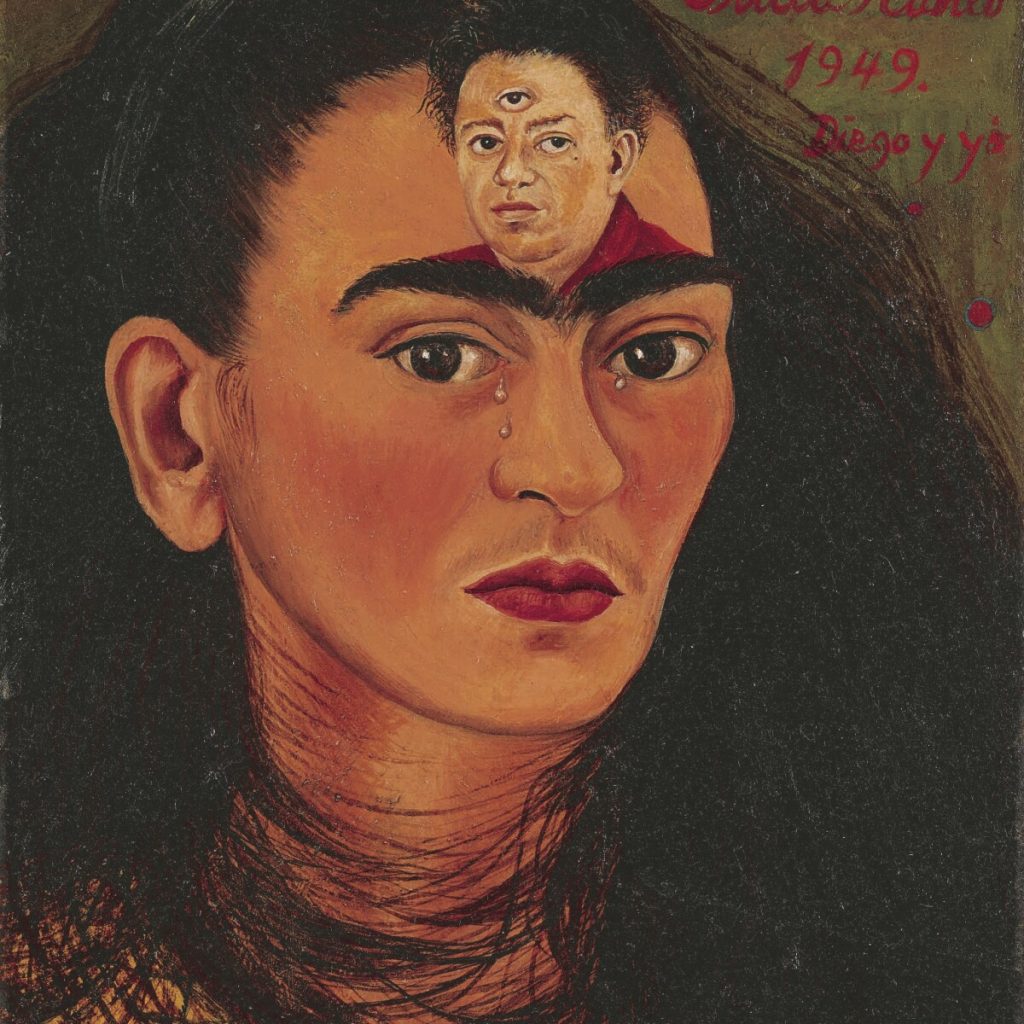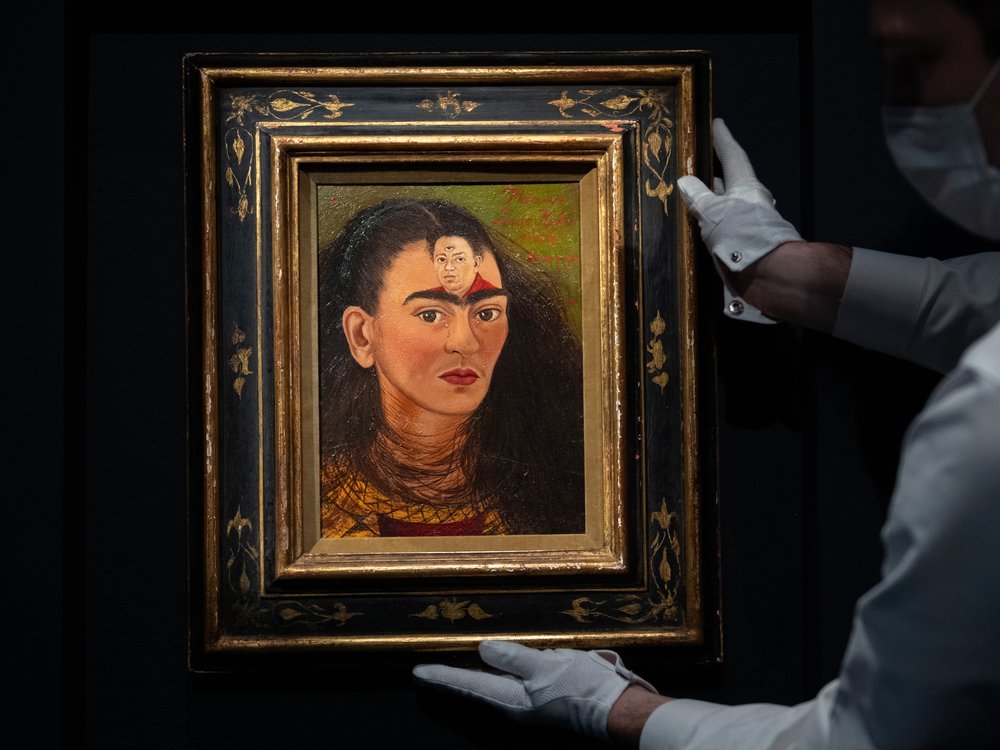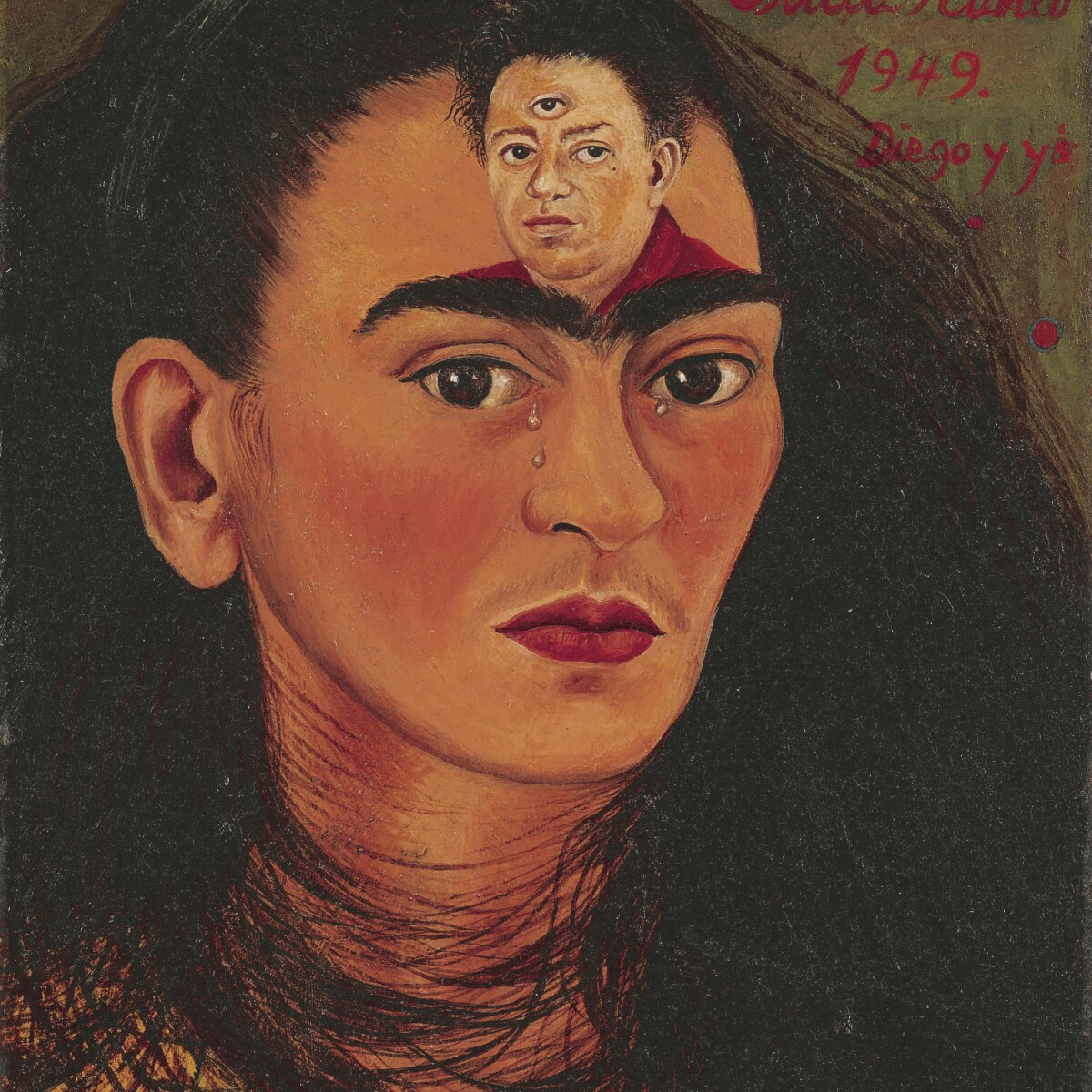A self-portrait by Mexican artist Frida Kahlo featuring her husband, artist Diego Rivera, sold at auction on Tuesday for US$34.9 million, the highest price ever paid for a painting by a Latin American artist.
Completed in 1949, Kahlo’s “Diego y yo” (Diego and I) went under the hammer at Sotheby’s in New York and sold to an unidentified buyer. The price included US$3.9 million in fees, the auction house said.
“This is one of the most important works by Kahlo ever to come to auction and we’re thrilled that it should be at Sotheby’s,” Oliver Barker, Sotheby’s auctioneer and senior director, said as he opened the bidding.
The painting shows a teary-eyed Kahlo with her hair loose around her, a portrait of Rivera bearing a third eye embedded above her brow.
Kahlo, who spent long periods bed-ridden after a traffic accident in her youth, created some 200 paintings, sketches and drawings – mainly self-portraits – in which she transformed her misfortune into works of bold colour and emblematic strength.

It is one of Frida Kahlo’s last self-portraits and represents the artist’s vulnerability and emotional turmoil over her husband Diego Rivera’s adultery.
Seven decades later, in a unique twist of fate, the painting has sold for almost $35m – making it the most expensive Latin American work of art to be sold at auction and beating the previous record held by Rivera himself.
Diego y yo (Diego and Me, 1949), which sold at Sotheby’s auction house in New York on Tuesday for $34.9m (£25m), shows Rivera in the centre of Kahlo’s forehead.
The oil painting has always fascinated art lovers with its depiction of the couple’s tumultuous relationship. Rivera is interpreted to illustrate Kahlo’s third eye, to symbolise the degree to which he occupied her consciousness.
Anna Di Stasi, the director of Latin American Art at Sotheby’s, called the sale “the ultimate revenge” and a validation of Kahlo’s talent.
“Painted in the same year her beloved Diego embarked on an affair with her friend, the Mexican golden age actress Maria Félix, this powerful portrait is the painted articulation of her anguish and sorrow,” Di Stasi said.
“You could call tonight’s result the ultimate revenge, but in fact it is the ultimate validation of Kahlo’s extraordinary talent and global appeal.
“Diego y yo is so much more than a beautifully painted portrait. It’s a painted summary of all of Kahlo’s passion and pain, a tour de force of the raw emotive power of the artist at the peak of her abilities.”
Kahlo and Rivera were married twice before Kahlo died aged 47 in 1954. She has become one of the best-known artists of the 20th century, but when she first set eyes on Rivera in 1922, Kahlo was a 15-year-old art student while he was a 36-year-old world-famous mural artist. She was instantly fascinated by him, and the pair married in 1928.
Kahlo once wrote in a notebook: “I suffered two great accidents in my life, one in which a streetcar knocked me down … the other accident is Diego.”
It was a striking comparison between her husband and the bus accident that nearly killed her at 18 and left her with horrific injuries including a broken spinal column.
Rivera’s affair with Félix became a public scandal, with newspapers reporting that he planned to marry her as soon as he could divorce Kahlo. He was quoted as saying: “I adore Frida, but I think my presence is very bad for her health.”
Though Kahlo made jokes about the affair and suggested she did not mind, the depth of her feeling is evident in Diego y yo, in which her normally tightly braided hair is loose, almost strangling her, her cheeks flushed and her gaze tearful – evocative of Madonna of the Sorrows. The painting last sold at Sotheby’s for $1.4m in 1990.
The auction house identified the painting’s buyer as Eduardo F Costantini, the founder of a museum in Buenos Aires. It was purchased for his private collection.

The stunning work became the most expensive Latin American artwork ever sold, breaking a benchmark set by the Mexican painter’s husband, Diego Rivera
Frida Kahlo’s 1949 self-portrait Diego y yo, or Diego and I, broke records yesterday, becoming the most expensive work by a Latin American artist ever sold at auction. The painting carried an estimate of $30 to $50 million and went under the hammer for $34.9 million.
As James Tarmy reports for Bloomberg, the Tuesday evening sale was guaranteed by a third party, meaning a buyer was already lined up to purchase Kahlo’s work at its minimum estimated value. The self-portrait was therefore expected to easily surpass a benchmark previously set by Kahlo’s husband, Diego Rivera. His 1931 painting The Rivals sold at Christie’s for $9.8 million in 2018 ($10.7 million today).
A Sotheby’s spokesperson identified the buyer as Eduardo F. Costantini, founder of the Museum of Latin American Art of Buenos Aires (MALBA) in Argentina. The collector tells Zachary Small of the New York Times that he plans to display the work at MALBA next year.
“I had looked at the painting so many times in books, then all [of a] sudden it came up for auction,” Costantini says. “I had started dreaming about buying the piece.”
Born in Coyoacán, a southern suburb of Mexico City, in 1907, Kahlo launched her painting career at the age of 18, when a traumatic bus accident left her bedridden for several months. Thanks in large part to productive relationships within the flourishing post-Mexican Revolution art community, Kahlo developed a unique Surrealist style that incorporated elements of Renaissance portraiture, Catholic ex-votos, folk art and Indigenous art. Her paintings probed questions of national and ethnic identity, history and communism, bisexuality, and painful events such as her infertility and Rivera’s infidelity. (The couple wed in 1929, divorced in 1939, remarried in 1940 and remained together until Kahlo’s death in 1954.)
Kahlo painted Diego y yo in the spring of 1949, during a difficult time in her life, notes Sotheby’s in work’s lot description. She was living in her beloved Casa Azul (Blue House), but her health had been steadily declining due to lingering complications from the 1925 accident. In the 11.6- by 8.8-inch oil painting, Kahlo renders her somber face encircled by strands of dark hair. A second miniature portrait of a three-eyed Rivera hovers just above the artist’s own eyes, which leak three small tears.
“Diego y yo epitomizes the painstakingly detailed rendering, complex iconography and deeply personal narratives that are hallmarks of [Kahlo’s] mature painting,” says Sotheby’s director of Latin American art, Anna Di Stasi, in a statement.
Kahlo dedicated the self-portrait to one of her frequent guests during this period: Florence Arquin, an art historian and educator based in Chicago. Arquin conducted several research trips to Mexico City on behalf of the State Department, becoming a well-known expert in Latin American art, per the Smithsonian’s Archives of American Art.
Writing on the back of the small canvas, Kahlo inscribed her painting to Arquin and her husband Samuel Williams: “For Florence and Sam with Frida’s love. Mexico, June 1949.”
Arquin grew particularly close to Rivera and Kahlo while living in Mexico City and working on a biography of Rivera in the 1940s and ’50s. She is credited with capturing many intimate photographs of the couple at their various homes in Coyoacán.
A portrait of Arquin painted by Rivera in 1943 is now housed in the Art Institute of Chicago’s collections. Arquin’s personal papers, including unpublished drafts of the Rivera manuscript and letters detailing a June 1949 trip, have been digitized and can be viewed through the Archives of American Art’s online portal.
When she died in 1954 at the age of 47, Kahlo left behind a relatively small body of work. Her oeuvre includes about 200 paintings, drawings and sketches, one-third of which are self-portraits, according to Sotheby’s. The limited supply of Kahlo artworks has led experts to predict that prices for her art will continue to skyrocket.
Sales like the record-breaking Sotheby’s auction track with the cult of celebrity that has emerged around the artist. Dubbed “Fridamania,” the surge in interest began when feminist scholars revived her oeuvre in the 1980s. Kahlo’s Two Nudes in a Forest (1939), her second-most expensive work, sold at Sotheby’s for $8 million in 2016 (around $9 million today). When Diego y yo last went under the hammer in 1990, it sold for $1.4 million ($3 million today), reports Kynala Phillips for NBC News.
The supply of Kahlo creations is further limited by the fact that Mexican law deems works by her and eight prominent 19th- and 20th-century artists “artistic monuments” that cannot be sold within the country, as Cultural Property News noted in 2018.

发表回复